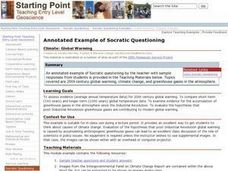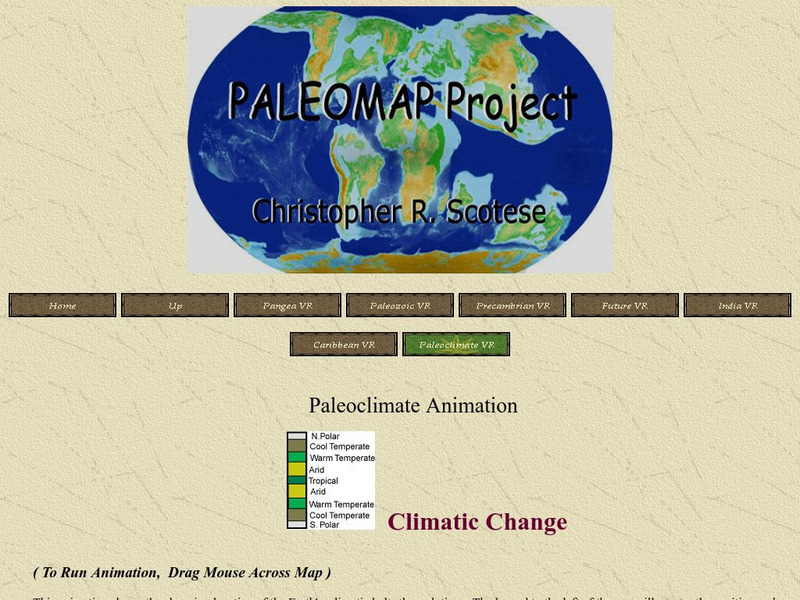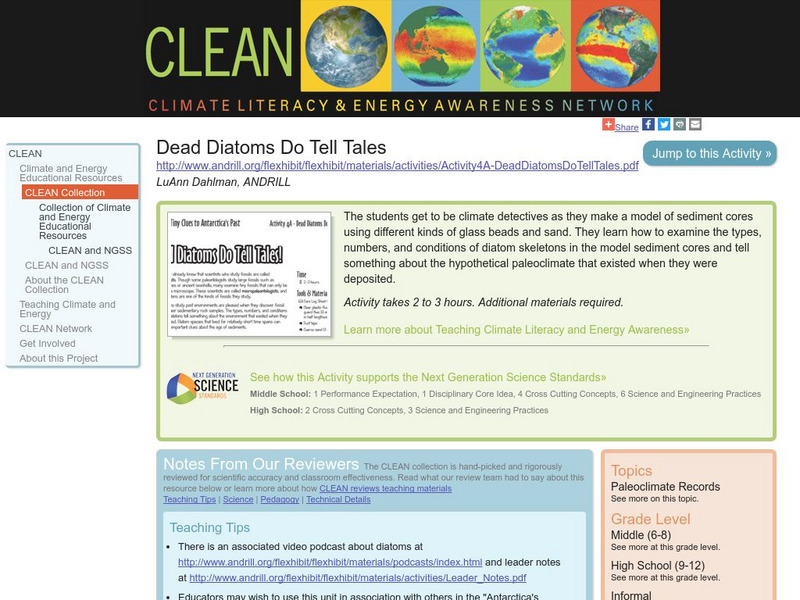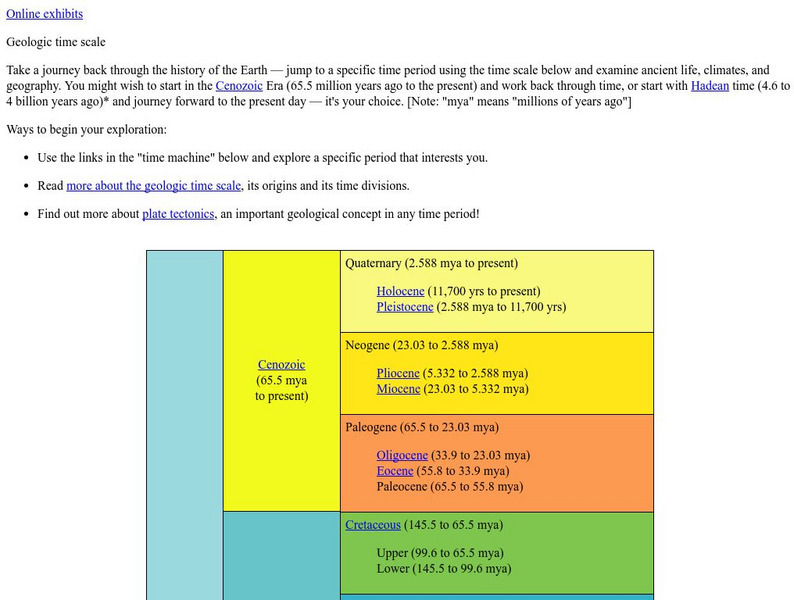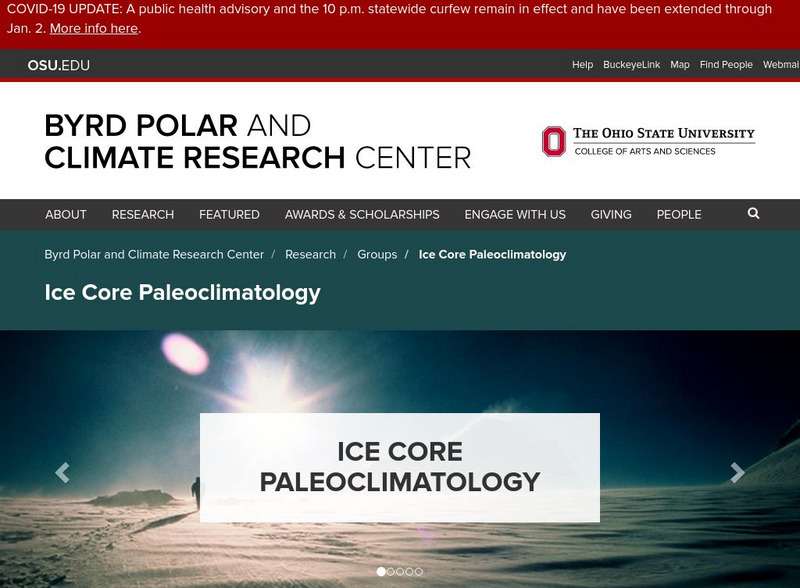Curated OER
Paleoclimate of the Hudson Valley
Learners recognize how the climate of the Hudson Valley has changed since the last glaciation and be able to explain these changes. They reconstruct the paleoclimate of the Hudson Valley.
It's About Time
Paleoclimates
How do scientists know what the Earth was like in the past? This second installment of a six-part series focuses on paleoclimates and provides an overview of how geologists determine information about past climates using fossil...
Center Science Education
Paleoclimates and Pollen
Demonstrate for your earth scientists how plant pollen of the past has become part of sedimentary deposits, providing clues about ancient climates. Then give them simulated sediment layer samples to analyze for different types of paper...
Howard Hughes Medical Institute
Paleoclimate: A History of Change
Earth's climate changed drastically throughout the history of the planet, so why do scientists blame humans for recent changes? Observe data covering the history of the planet that proves the natural climate change patterns. Then, learn...
Curated OER
Paleoclimates and Pollen
Young scholars analyze soil for types of pollen to determine the probably climate conditions. In this earth science lesson, students make conclusions on what a climate is like based on soils samples. Young scholars use a model soil...
Curated OER
Writing about the climate
Students research the contributing factors to the Earth's paleoclimate. They determine the relevant climate data and use it to construct a science argument. In the process, they access data, capture images of the data plots, and...
Chicago Botanic Garden
Historical Climate Cycles
Ice core samples give scientists access to climates of old—those from more than 800,000 years ago. Through an analysis of various temperature graphs from ice cores, tree rings, and weather stations, scholars compare historical climates...
Curated OER
Natural Records of Change: Working with Indirect Evidence of Past Climates
Middle schoolers take part in a dice game to better explain the differences between direct and indirect evidence. They apply this knowledge to how scientists have used both types of evidence to determine how climate has changed over time.
Curated OER
Annotated Example of Socratic Questioning: Climate: Global Warming
Young scholars compare and discuss short-term and longer-term global temperature data. They evaluate data from three sets of graphs and then participate in a structured whole class Socratic discussion on the possible causes of climate...
Curated OER
Glacial Geology in the Field
Students examine the origin of glaciers, how glacial sediments are deposited, and what sedimentary records of glaciation provide about source and process of glaciers in a field lab.
Science Education Resource Center at Carleton College
Serc: Topic Guide: Paleoclimate
In this activity students form groups, conduct research into paleoclimate, and report their findings in the form of a presentation.
University Corporation for Atmospheric Research
Ucar: Paleoclimates and Pollen
In this extensive lesson plan, learners examine and investigate pictures of pollen grains to determine the likely climate at the time the pollen was shed.
Howard Hughes Medical Institute
Hhmi: Bio Interactive: Paleoclimate: A History of Change
Learn about the history of Earth's climate in this Click and Learn. Learn how many factor control Earth's climate. Specifically, examine two of the most important factors: solar radiation and the composition of Earth's atmosphere.
Other
Paleoclimate Animation
This animation allows you to see how the continent's climates changed as they drifted throughout history.
Climate Literacy
Clean: Paleoclimate Reconstruction Lab
A lesson plan for an activity where students relate weather and climate patterns to understand annual sediment deposition. During the lesson plan students reconstruct climates from the past 300 years using lake sediment data. Lesson...
Climate Literacy
Clean: Dead Diatoms Do Tell Tales
Students take on the role of climate detectives in this climate investigation. Teams make a model of sediment cores using glass beads and sand, study the core samples, and tell something about the hypothetical paleoclimate that existed...
Science Education Resource Center at Carleton College
Serc: Inquiry Into High Resolution Ice Core and Marine Sediment Records
Activity in which questions are provided relating to interpreting paleoclimate data such as characteristics that make sites favorable for paleoclimate records, locating sites using a map, finding patterns and correlations in the data,...
National Earth Science Teachers Association
Windows to the Universe: Paleoclimates: Climates of the Past
Learn how climate has changed in the past and how it relates to global warming. Links to related material.
Northern Arizona University
Land Use History of North America: Fossil Pollen (Palynology)
Use this site to learn why fossil pollen is a useful tool for determining paleoclimates.
University of California
Ucmp: Web Geological Time Machine
The Museum of Paleontology at Berkeley offers an online geological time machine which allows you to catch a glimpse of ancient eras in earth's history. Click into an "Era" to learn about its stratigraphy, life forms, localities, and...
Science Education Resource Center at Carleton College
Serc: Climate Time Line Information Tool
A tool that summarizes climate history for time spans from 1 year to 100,000 years ago and beyond. It explores the relation between human development, weather, and climate. Students learn how past climate is measured, provides basic...
Texas A&M University
Ocean World: Bringing the Ocean to the Classroom
Online resource for students and teachers to see information on icebergs, fisheries, coral reefs, waves, currents and more. Provides teachers with learning activities. Has its own ask-an-expert site (Ask Dr. Bob), and provides real-time...
Ohio State University
Byrd Polar Research Center: Ice Core Paleoclimatology Research Group
This site explains the research of the Ice Core Paleoclimatology Group. See how they are coring ice samples all around the world to help better understand Earth's changing climate. Provides links to teaching materials.
Science Education Resource Center at Carleton College
Serc: Marine Oxygen Isotopes and Changes in Global Ice Volume
Students explore marine oxygen-isotope records for the past 2 million years using real paleoclimate data. They will discover trends in a time series pertaining to long-term ice volume changes.










